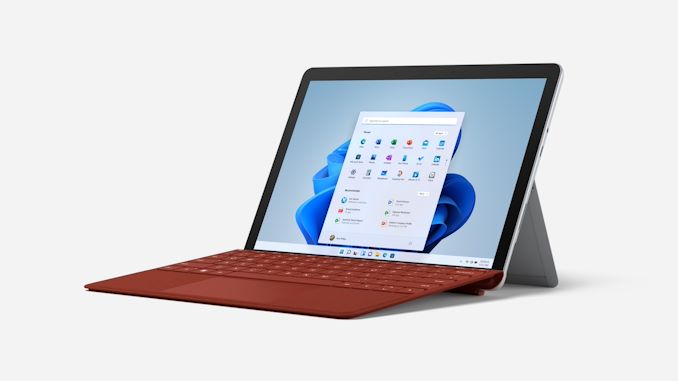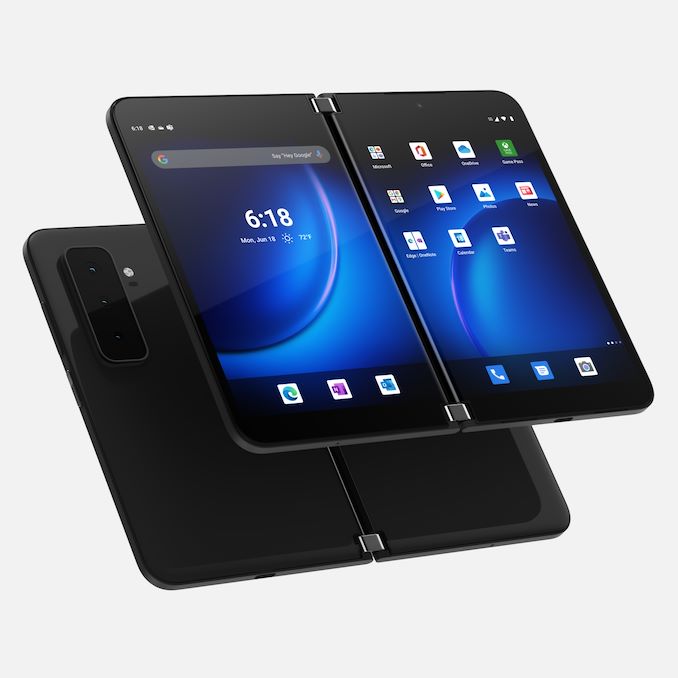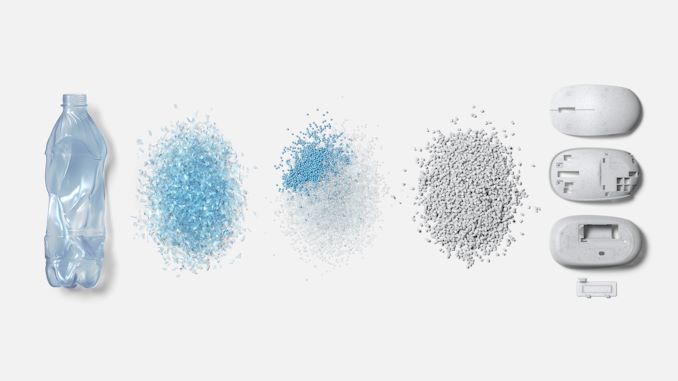Surface Laptop Studio, Surface 8 Pro Lead Microsoft's New Surface 2021 Lineup
by Brett Howse on September 22, 2021 12:00 PM ESTSurface Go 3
There is a small bump for the Surface Go line, going from version 2 to version 3. The Surface Go is the smallest, lightest, and least expensive Surface device in the lineup, but has suffered from anemic performance compared to the rest of the devices. The only significant change to the Surface Go 3 is that there is now an optional Core i3-10100Y processor, which is a higher speed bin of the venerable Amber Lake-Y dual core SoC that Microsoft used in the Surface Go 2. The base offering still comes with a Pentium dual-core, though the Pentium Gold 6500Y used here is a big step up in some ways since it can turbo to 3.4GHz, whereas the Go 2's Pentium 4425Y lacked turbo altogether.
Meanwhile the base model still ships with just 64 GB of eMMC storage, although 128 and 256 GB SSDs are available, with the latter being only on the commercial lineup. Luckily the price didn’t change, with the Surface Go 3 still starting at just $400, although that model with 4 GB of RAM and 64 GB of eMMC storage would feel awfully slow for most people.
Surface Duo 2
The second-generation Microsoft-designed folding phone is also being announced and adds performance and usability to help it compete in the high-end of the mobile phone space. Now shipping with the Qualcomm Snapdragon 888 SoC, the Surface Duo 2 adds a lot to its camera department with the inclusion of a triple-camera for wide, ultra-wide, and telephoto photos.
The folding display also gets a size bump from 5.6-inch individual screens to 5.8-inch panels, which provides an effective display size of 8.3-inches when both are opened. The Surface team also took the opportunity to add 5G support, which is also expected in 2021.
For multi-tasking, there is 8 GB of LPDDR5 memory, and storage options are 128 GB, 256 GB, or 512 GB.
The Surface Duo 2 is really supposed to showcase Microsoft’s Android app suite for Office, and with the updates, it should do a much better job considering the high-entry price of $1500.
Accessories
In addition to the devices, Microsoft is also releasing a couple of new accessories. The Microsoft Ocean Plastic Mouse is made from 20% recycled ocean plastic and is just $25.
The Surface Adaptive Kit, designed in partnership with people with disabilities, is a set of textured labels which can be attached to the keyboard and ports to make it easier to identify what they are by touch and color.
Summary
Microsoft’s Surface team has grown from just designing a couple of devices, to a wide swath of devices covering a large part of the PC market, and they have expanded beyond those borders too with the Surface Duo and Surface Duo 2. Looking at the devices holistically, the design team generally tries to offer something with a slight twist compared to the other designs on the market, and some are more successful design wins than others. The Surface Pro, as an example, as created an entire genre of devices that mimic it, and the update being announced today is a solid refresh of that design which should allow Surface Pro to continue to be the industry leader.
The Surface Laptop Studio is an interesting design, and while not a completely new concept, it looks to be a well-executed take on the convertible laptop. From the specifications, it appears to be taking over from the Surface Book, which was their previous performance-laptop. It is less complicated than the Surface Book, which should lead to an overall better product.
The Surface Pro X certainly did not see very much love, and Windows on Arm did not get advanced at all on the hardware front today. The Surface Pro 8 now gets the same 13-inch display, which is good for the Pro 8, but does diminish the Pro X. Surface Go 3 also got just the tiniest of updates and is still a somewhat awkward device. The base model is inexpensive, but unimpressive, and when the necessary options are chosen, the price creeps up. It is still a well-built device, with a wonderful magnesium allow chassis and individually calibrated display, which sounds great for $400, but the $400 model is significantly more disappointing than the upgraded models sadly.
Microsoft tends to update their hardware at almost random intervals, but quibbles aside, these updates are all welcome, with some really excellent changes, such as the addition of Thunderbolt 4. I look forward to being able to try some of these devices out in the future and see how much the changes impact the device experience.
















113 Comments
View All Comments
SaolDan - Wednesday, September 22, 2021 - link
Yeah 🍎 is killing it on the SOC side of things. I myself don't like the Apple ecosystem but i give credit where credit is due.Kangal - Thursday, September 23, 2021 - link
Apple is killing it with their:- SoC's (CPU, GPU, and everything else)
- Hardware (Just feels great, no huge QC issues, like for instance, GPD devices)
- Software (their SDK is tight, Swift is revolutionary, Metal is great)
What I don't know about is how Apple's is going from a UI viewpoint.
The Apple Watch UI isn't good in my humble opinion. The iPhone X UI felt janky/less intuitive to me, not sure if they've kept it the same, gotten worse, or made improvements since. Their iPadOS seems good for the iPad Mini as a mostly consuming device rather productivity. Not sure if iPadOS is actually good or powerful when it's on a large iPad Pro. I don't know how the latest iOS (sorry macOS X) experience is on the 2020 M1 MacBook Pro laptops. I don't know about the AppleTV's UI it could be good or bad. Their Apple CarPlay however is surprisingly pleasant to use.
...is there anyone who has an accurate opinion (are they killing it) on their UI status?
gijames1225 - Thursday, September 23, 2021 - link
I'd temper the praise of their software / development ecosystem (but fully agree that hardware and chips are top notch). Swift is hardly revolutionary, and Apple is by far the most proprietary, heavy-handed, and locked down ecosystem of any of the big players currently. Apple also goes out of its way to not support open standards whenever they can make a proprietary, not-cross-platform one and to build those walls higher.All my gratitude for Jobs helping kill Flash has long since withered as a developer. But MacBooks sure are nice piece of kit still, lol.
DigitalFreak - Thursday, September 23, 2021 - link
I just bought a Macbook Air M1 for some work stuff, and it's the first time I've used macOS. My god, it feels like moving back to the dark ages after using Windows 10.DigitalFreak - Thursday, September 23, 2021 - link
That's what happens when you own both the OS and the hardware it runs on.Microsoft is stuck having to keep Windows on everything from a potato to devices with hundreds of cores (re: Azure). Apple also has the luxury not having to deal with backwards compatibility, aside from the extremely rare instance when they switch architectures.
I have to applaud Microsoft from finally drawing a line in the sand with Windows 11 device support. Though it sounds like they're backing away from it a bit more every day.
ChrisGX - Friday, September 24, 2021 - link
>>That's what happens when you own both the OS and the hardware it runs on.Yes, the control of the stack thing makes life a bit easier for Apple but it doesn't really explain why Apple silicon has started to best Intel silicon in areas that Intel was thought to be invulnerable. Basically, Apple aims to produce only a small number of processors that are the best processors that Apple can make. Those processors will be used in Apple's product lines as befits the requirements of the specific products and Apple's silicon development strategy. The M1 processor that has already be released is simply faster and more energy efficient that the 28W Tiger Lake parts (UP3 variety) that it is a direct rival to. That is what benchmarks on this site and elsewhere show. But, control of the stack will help Apple to play its own game as it extends its silicon rivalry with Intel beyond laptops and into other product domains that Apple operates in.
damianrobertjones - Wednesday, September 22, 2021 - link
Eh? Touch screens, stylus... that's all I've got.Retycint - Thursday, September 23, 2021 - link
None of the MacBook Pros are competitive with the Surfaces when it comes to touchscreens or stylus input though. As long as Apple refuses to make iPadOS into a full OS, the Surface line will always remain competitiveDigitalFreak - Thursday, September 23, 2021 - link
I don't get their reluctance to do it. At this point the new iPad Pro is a Macbook without a built in keyboard. Same CPU/GPU. If Parallels had a version that ran on the M1 iPads, I would have jumped on one instead of the Air.ChrisGX - Friday, September 24, 2021 - link
>> None of the MacBook Pros are competitive with the Surfaces when it comes to touchscreens or stylus input though.Are you talking about existing models or some or all of the new devices? And, is that your opinion or do you have an authoritative source for the contention? I have no direct experience of the existing models but most reviews/video reviews that I have read/seen rate the iPad Pro better on both of those counts.